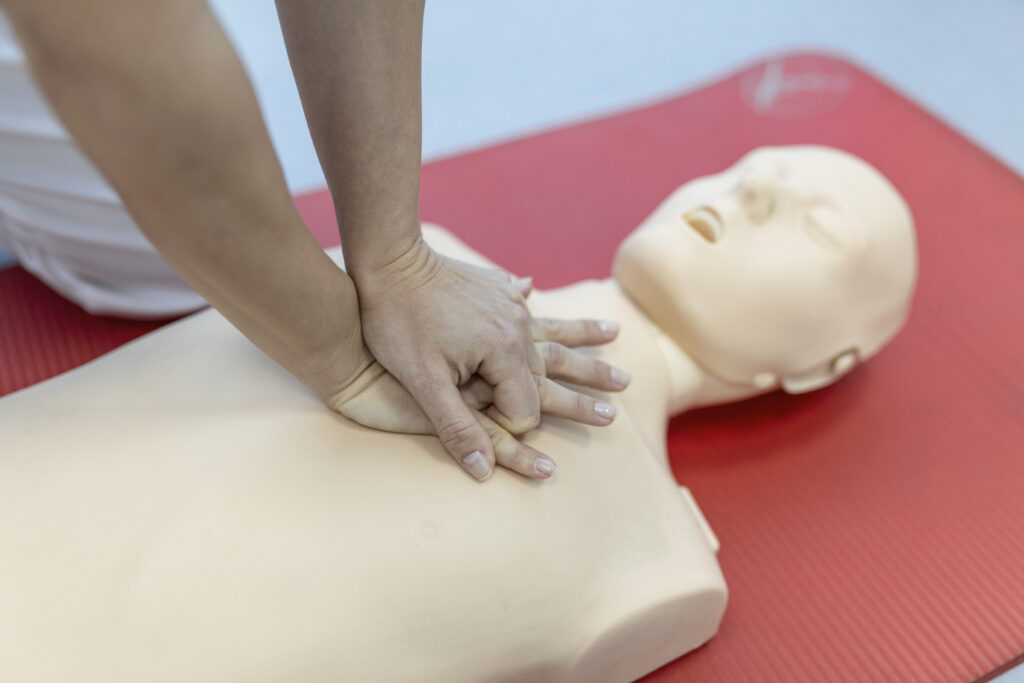5 Serious Emergencies When CPR Is Needed: Knowing CPR and first aid basics are the best way to know what to do if a medical emergency happens to you, a loved one, or even a stranger.
Attempting to provide CPR is often better than doing nothing. Sometimes, acting quickly can save a person’s life.
What Is CPR?
Cardiopulmonary resuscitation (CPR) is a combination of mouth-to-mouth and chest compression techniques designed to help a victim who is unresponsive and not breathing.
Through the proper use of lifesaving techniques, you can prevent deterioration by helping the person avoid permanent damage to the brain and possibly even death.
Performing CPR care in a timely and effective manner is important to improve the chances of survival in a cardiac arrest or in the event that the person’s blood and oxygen supplies are not circulating properly.
5 Serious Emergencies When CPR Is Needed
1. Drowning
Drowning is essentially respiratory impairment from liquid submersion, resulting in decreased oxygen levels in the bloodstream. The lack of oxygen and other factors (such as water entering the lungs) can put you at risk of cardiac arrest and death.
Drowning is the third most common cause of accidental deaths globally. In Australia, records show more drowning deaths over the past 12 months, which is 15% higher than the last year.
When someone is drowning, it is extremely critical to take the necessary actions needed in order to help save lives. Here are a few steps you can take in drowning or near-drowning emergencies:
- Look for help. Ask other bystanders in the area to look for a nearby lifeguard. If no lifeguard is available, immediately call Triple Zero (000) for assistance.
- Once EMS is alerted, move the person out of the water if possible.
- Check for breathing. Put your ear near their mouth and nose and observe if there are any chest movements that indicate that the person is breathing.
- Check for pulse. Check the person’s pulse by placing two fingers on the inside of their wrist or neck to try and find a beat.
- If there are no signs of breathing or pulse, performing CPR is the next best course of action until further help arrives.
2. Cardiac Arrest
CPR is one of the most valuable life skills anyone can learn, especially when the person suffers from abnormal or no breathing.
A person suspected of cardiac arrest may be breathing for a while and soon experience gasping for breath. In this scenario, perform CPR right away.
Perform 30 chest compressions with 100-200 chest compressions every minute, followed by two consecutive mouth-to-mouth resuscitations.
3. Unconsciousness
Bystander CPR plays a crucial role in the person’s survival if they become unconscious at some point. Before proceeding with the first aid steps, try waking them up first, and if they remain unresponsive, check for any signs of pulse or breathing.
If there is no indication that the person is breathing or has a pulse, call an ambulance for help.
As per instructions from the American Heart Association and Emergency Cardiovascular Care, if a person is unconscious, bystanders are liable to administer CPR to get the person’s heart beating again.
Until help arrives, place the person in the recovery position and observe for any signs of change. If the person remains unresponsive, immediately begin CPR. Continue the cycle of chest compressions and rescue breathing until the person regains consciousness or until emergency services arrive.
4. Fires And Smoke Inhalation
Smoke affects the body in many different ways. Breathing in smoke causes harmful gases and other particles to enter your lungs. These can inflame your lungs and airways, causing them to swell.
The swelling can then lead to blockages that can prevent oxygen from transferring into the bloodstream. Without oxygen, the body can suffer serious damage, particularly in the vital organs.
All these effects from fires and smoke getting into your lungs can lead to acute respiratory distress. This condition affects the breathing system causing it to function abnormally and eventually resulting in respiratory and cardiac arrest.
Anyone who experienced fire and smoke inhalation requires immediate first aid treatment. Here’s what to do.
- Call triple zero (000) for emergency medical assistance.
- Approach the person and try to remove them from the smoke-filled area only if it is safe to do so. Once clear, move them to a location with clean, fresh air.
- Check the person’s circulation, airway, and breathing (CAB).
- If the person is unresponsive and shows no signs of breathing and circulation, begin CPR while waiting for emergency help to arrive.
5. Electrocution
Electric shock or electrocution injury occurs when a person directly interacts with a voltage source, causing the electrical current to travel through the body. This can result in internal damage, external burns, and in some cases, cardiac arrest.
If a person goes into cardiac arrest, administer CPR right away. Place your hand in the center of the chest (with one hand on top of the other) and start pressing down firmly at a rate of around 100-120 compressions per minute. Do it alternatively with mouth-to-mouth resuscitation.
When doing rescue breathing, make sure the person’s airway is open by slightly tilting the head back and lifting the chin. Pinch their nose, place your mouth over theirs, and start blowing into their mouth to facilitate artificial breath.
Get CPR Training
Although evidence indicates that the performance of CPR can significantly improve survival and outcomes from serious emergencies each year, less than 3% of the overall population receives CPR training, leaving many bystanders unprepared to respond to various medical situations.
Make some time and enroll in a CPR course to be able to help with utmost pride when the occasion arises to help someone in need. The training will not only provide you with the skills and knowledge for personal use, but you will also get a CPR certificate that will help you enhance your career.
Book a CPR training course today.








